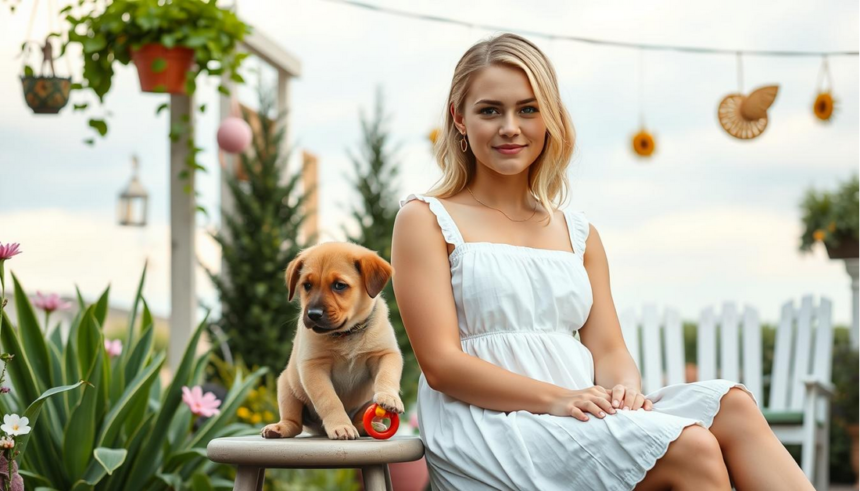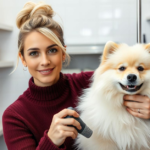India customers to view on amazon.in
Creating a Pet-Safe Garden at Home
As a pet owner, ensuring your furry friends can enjoy the outdoors with you is crucial. Pet-friendly landscaping is not just about keeping your pets safe; it’s also about creating a beautiful outdoor space for the whole family to enjoy.
- Understanding Pet Behavior in Outdoor Spaces
- Common Garden Hazards for Pets
- Toxic Plants and Flowers
- Chemical Dangers: Fertilizers and Pesticides
- Physical Hazards in Garden Design
- Planning Your Pet-Safe Garden Layout
- Pet-Friendly Plants for Your Garden
- Non-Toxic Flowers and Ornamentals
- Safe Herbs and Vegetables
- Durable Plants That Withstand Pet Activity
- Regional Plant Considerations for US Gardens
- Plants to Avoid in a Pet-Safe Garden
- Creating a Pet-Safe Garden at Home: Essential Features
- Secure Fencing and Boundaries
- Safe Pathways and Surfaces
- Water Features: Safety Considerations
- Shade and Protection from Elements
- Pet-Friendly Gardening Materials and Methods
- Safe Mulch and Soil Options
- Natural Pest Control Alternatives
- Pet-Safe Garden Tools and Storage
- Eco-Friendly Options for American Gardens
- Troubleshooting Common Pet Garden Problems
- Preventing Digging Behaviors
- Deterring Pets from Eating Plants
- Managing Pet Waste in Garden Areas
- Solutions for Fence Jumpers and Escape Artists
- DIY Projects for Enhanced Pet Garden Enjoyment
- Building Pet-Specific Garden Features
- Creating Enrichment Opportunities
- Sensory Gardens for Pets
- Budget-Friendly Pet Garden Projects
- Conclusion: Enjoying Your Garden Together
- FAQ
- What are some pet-friendly plants I can include in my garden?
- How can I prevent my dog from digging up my garden?
- What are some common toxic garden plants that I should avoid?
- How can I create a pet-safe water feature in my garden?
- What are some eco-friendly gardening practices I can adopt to keep my pets safe?
- How can I deter my pet from eating my plants?
- What are some DIY projects I can do to enhance my pet garden?
- How can I manage pet waste in my garden?

A pet-safe garden involves choosing the right plants and designing your outdoor space to prevent any harm to your pets. This includes avoiding toxic plants and ensuring that your garden is free from hazards.
Key Takeaways
- Understand the importance of pet-safe gardening.
- Learn how to choose pet-safe plants.
- Discover how to design a pet-friendly outdoor space.
- Identify common hazards in gardens for pets.
- Find tips on maintaining a safe and enjoyable garden for pets.
Understanding Pet Behavior in Outdoor Spaces
Creating a pet-safe garden starts with understanding how your pets interact with outdoor spaces. This knowledge is crucial for designing a garden that is both enjoyable for your pets and safe for them to explore.
How Dogs Interact with Gardens
Dogs often view gardens as areas to explore, play, and sometimes dig. Their interaction can be energetic, involving running, jumping, and potentially damaging plants. To create a pet-friendly garden design, it’s essential to consider these behaviors and plan accordingly.

How Cats Interact with Gardens
Cats, on the other hand, tend to interact with gardens in a more subtle way. They may enjoy hiding among plants, watching wildlife, or using garden features as scratching posts. Understanding these behaviors can help in creating a safe outdoor space for pets.
Small Pets and Outdoor Safety Concerns
Small pets, such as rabbits or guinea pigs, have different needs and risks in outdoor spaces. They require secure enclosures to protect them from predators and prevent escape. Ensuring their safety involves careful planning of their outdoor areas.
| Pet Type | Common Behaviors | Safety Concerns |
|---|---|---|
| Dogs | Running, digging, playing | Damaging plants, injury from sharp objects |
| Cats | Hiding, scratching, watching wildlife | Toxic plant ingestion, injury from falls |
| Small Pets | Exploring enclosures, hiding | Predator risk, escape, health issues from stress |
By understanding these behaviors and concerns, pet owners can create an outdoor pet safety plan that ensures their garden is a haven for their pets.
Common Garden Hazards for Pets
Creating a pet-safe garden requires awareness of the potential hazards that can harm your pets. Gardens can be hazardous for pets if not designed with their safety in mind.
Toxic Plants and Flowers
Many common garden plants and flowers are toxic to pets. For example, lilies are highly toxic to cats, while sago palms can be fatal to dogs if ingested. It’s crucial to research the toxicity of plants before introducing them into your garden.
Chemical Dangers: Fertilizers and Pesticides
Fertilizers and pesticides can be harmful if ingested or if they come into contact with your pet’s skin. Opting for organic or pet-safe alternatives can significantly reduce these risks. Always follow the instructions on the product label and keep these chemicals out of reach of your pets.
Physical Hazards in Garden Design
Garden design can also pose physical hazards to pets. Two significant risks include sharp objects and tools, and water features.
Sharp Objects and Tools
Gardening often involves the use of sharp objects and tools, which can be dangerous if left unattended. Ensure that these items are stored securely after use.
Water Features and Drowning Risks
Water features can be a beautiful addition to a garden but pose a drowning risk to pets. Supervising your pets when they’re in the garden and considering fencing off water features can help mitigate this risk.

By understanding these hazards and taking steps to mitigate them, you can create a safer and more enjoyable outdoor space for your pets.
Planning Your Pet-Safe Garden Layout
Designing a pet-friendly garden requires a thoughtful approach to ensure both your pets and plants thrive. A well-planned garden layout can help prevent accidents and create a harmonious outdoor space for both pets and their owners.
Designated Pet Areas vs. Plant Areas
One key aspect of a pet-safe garden is separating pet areas from plant areas. This can be achieved by using fencing or other barriers to create distinct zones within the garden. By doing so, you can protect your plants from being damaged by pets and reduce the risk of pets ingesting toxic plants.

Creating Shade and Shelter
Providing shade and shelter is crucial for pets that spend time outdoors. Consider incorporating features like doghouses, gazebos, or pergolas to create shaded areas. You can also use trees or umbrellas to provide additional shade.
Incorporating Pet Play Zones
Pet play zones are an essential part of a pet-friendly garden. These areas can be designed specifically for dogs or cats, providing them with spaces to play and exercise.
Dog-Specific Play Areas
For dog owners, creating a dog agility course or a designated digging area can be a great way to keep pets entertained. Consider incorporating features like tunnels, jumps, and interactive toys.
Cat-Friendly Spaces
Cats also benefit from having their own spaces within the garden. Consider creating a cat agility course or providing scratching posts and climbing structures. As “Cats are natural climbers, so incorporating vertical spaces can be particularly appealing to them.”
By incorporating these elements, you can create a pet-safe garden that is both functional and enjoyable for your pets. As a pet owner, it’s essential to remember that “a safe garden is not just about the plants, but also about creating a space that meets your pets’ physical and emotional needs.”
Pet-Friendly Plants for Your Garden
A pet-safe garden starts with the right plants, ensuring a safe outdoor space for your pets. Choosing the right flora is crucial for pet owners who want to create a harmonious and safe environment for their animals.
Non-Toxic Flowers and Ornamentals
When it comes to flowers and ornamentals, there are several options that are safe for pets. Some examples include:
- Marigolds – Bright and cheerful, marigolds are non-toxic to pets.
- Sunflowers – These tall, happy flowers are safe for your pets to be around.
- Zinnias – Adding a pop of color to your garden, zinnias are pet-friendly.
Safe Herbs and Vegetables
Growing your own herbs and vegetables can be a great way to have fresh produce on hand, and many are safe for pets. Some examples include:
| Herb/Vegetable | Pet Safety |
|---|---|
| Basil | Non-toxic to pets |
| Carrots | Safe for pets to eat |
| Cilantro | Pet-friendly |
Durable Plants That Withstand Pet Activity
Pets can sometimes be rough on plants, so choosing durable flora is essential. Succulents are a great option as they are hardy and can withstand accidental knocks or pet interactions.

Regional Plant Considerations for US Gardens
Different regions in the US have different climates, which affects the types of plants that can thrive. For example, in dry climates like the Southwest, drought-resistant plants like succulents are ideal. In contrast, the Southeast’s humid climate is suitable for plants like azaleas and gardenias, which are non-toxic to pets.
By choosing the right pet-friendly plants, you can create a safe and enjoyable outdoor space for both you and your pets.
Plants to Avoid in a Pet-Safe Garden
To keep your pets safe, it’s essential to identify and avoid toxic garden plants. While there are many beautiful plants that can enhance your garden’s aesthetic, some can be harmful or even fatal to your pets if ingested.

Common Toxic Garden Plants
Several common garden plants are toxic to pets. For example, lilies are highly toxic to cats, and even small amounts can cause severe kidney damage. Sago palms, often used in landscaping, contain a toxin called cycasin that can be fatal to pets if ingested. Other plants to avoid include oleander, castor bean, and autumn crocus.
- Lilies
- Sago palms
- Oleander
- Castor bean
- Autumn crocus
Seasonal Dangers to Watch For
Some plants are more dangerous during certain seasons. For instance, holiday plants like mistletoe and holly can be toxic to pets. In the fall, autumn crocus can be particularly tempting due to its vibrant colors, but it’s highly toxic. Being aware of these seasonal dangers can help you keep your pets safe year-round.
What to Do If Your Pet Ingests a Toxic Plant
If you suspect your pet has ingested a toxic plant, it’s crucial to act quickly. Here are the steps you should follow:
Emergency Steps
- Remain calm to ensure you can act effectively.
- Identify the plant if possible.
- Contact your veterinarian or a pet poison hotline immediately.
- Follow any advice given by the professional you contact.
When to Contact Your Veterinarian
If your pet shows any symptoms of poisoning, such as vomiting, lethargy, or difficulty breathing, contact your veterinarian immediately. Even if your pet seems fine, it’s still important to consult with your veterinarian as some toxins can cause delayed reactions.
By being aware of the common garden toxins dangerous to pets and knowing what to do if your pet ingests a toxic plant, you can significantly reduce the risk to your pets and enjoy a safe and beautiful garden together.
Creating a Pet-Safe Garden at Home: Essential Features
Designing a pet-safe garden involves more than just choosing the right plants; it’s about creating a secure outdoor space for pets to enjoy. A well-designed garden can be a haven for both pets and their owners, providing a safe area for recreation and relaxation.
Secure Fencing and Boundaries
A critical aspect of a pet-safe garden is secure fencing. The fence should be high enough to prevent jumping and sturdy enough to withstand attempts to dig through or push over. For many pets, especially dogs, a securely fenced garden is a safe haven where they can play without the risk of escaping.

Safe Pathways and Surfaces
The materials used for pathways and surfaces in your garden are crucial for pet safety. Avoid using gravel or other materials that can be harmful if ingested. Instead, opt for pet-friendly alternatives like grass or smooth paving stones that are comfortable for pets to walk on.
Water Features: Safety Considerations
If you’re considering adding a water feature to your garden, safety should be your top priority. For pet owners, this means either avoiding water features altogether or ensuring that any pond or pool is safely fenced off to prevent accidental drowning.
Shade and Protection from Elements
Providing shade and protection from the elements is another essential feature of a pet-safe garden. This can be achieved through the strategic planting of trees or the installation of a canopy or pergola. Ensuring your pets have a comfortable place to rest is key to creating a pet-proof garden features that they will love.
By incorporating these essential features, you can create a safe outdoor space for pets that is both enjoyable and safe. Whether you’re starting from scratch or modifying an existing garden, focusing on security, safety, and comfort will ensure that your garden is a haven for your pets.
Pet-Friendly Gardening Materials and Methods
When it comes to creating a pet-safe garden, the materials and methods you use are just as important as the plants you choose. Your gardening practices can significantly impact your pets’ safety and well-being.
Safe Mulch and Soil Options
Choosing the right mulch and soil is crucial for a pet-safe garden. Opt for organic mulch like wood chips or bark, which are less likely to contain harmful chemicals. For soil, consider using compost made from natural, non-toxic materials.

Natural Pest Control Alternatives
Instead of using chemical pesticides, explore natural pest control methods. These can include introducing beneficial insects, using physical barriers, or applying natural deterrents like garlic or hot pepper sprays.
Pet-Safe Garden Tools and Storage
Ensure that your garden tools are stored safely out of your pets’ reach. Consider using eco-friendly gardening tools made from sustainable materials. Proper storage can prevent accidents and poisoning.
Eco-Friendly Options for American Gardens
Adopting eco-friendly gardening practices not only benefits the environment but also enhances your pets’ safety. This includes using recycled materials for garden paths and choosing plants that require less water and care.
By incorporating these pet-friendly gardening materials and methods, you can create a safer, more enjoyable outdoor space for both you and your pets.
Troubleshooting Common Pet Garden Problems
Even with a well-designed pet-safe garden, issues like digging and plant eating can still arise. Addressing these common problems is key to maintaining a harmonious outdoor space.
Preventing Digging Behaviors
To deter digging, provide your pets with designated digging areas filled with sand or loose soil. You can also try burying toys or treats to distract them from unwanted digging spots.
Deterring Pets from Eating Plants
To stop pets from eating plants, use positive reinforcement training and keep toxic plants out of reach. Consider using pet-deterrent granules or sprays on plants you want to protect.

Managing Pet Waste in Garden Areas
Managing pet waste is crucial for a clean garden. Regularly clean up after your pets and consider composting their waste.
Solutions for Fence Jumpers and Escape Artists
For pets that jump fences, consider increasing the fence height or adding a pet-deterrent on top. For escape artists, ensure all gates are securely locked.
By addressing these common issues, you can enjoy a more harmonious and safe outdoor space with your pets.
DIY Projects for Enhanced Pet Garden Enjoyment
Enhancing your garden with pet-centric DIY projects is a great way to ensure a safe and enjoyable outdoor space. By incorporating elements that cater to your pets’ needs, you can create a haven that promotes their well-being and happiness.
Building Pet-Specific Garden Features
One of the most effective ways to enhance your pet garden is by building features that are specifically designed for your pets. This can include:
Dog Agility Equipment
Creating a dog agility course in your garden can provide your canine companions with the physical exercise they need. You can build tunnels, jumps, and weave poles using materials like PVC pipes and wooden planks.
Cat Climbing Structures
Cats love to climb and perch. Building a cat agility tower or cat shelves can give your feline friends a place to observe their surroundings, exercise, and play.
Creating Enrichment Opportunities
Enrichment activities are crucial for keeping your pets mentally stimulated. You can create enrichment opportunities by hiding treats or toys around the garden, encouraging your pets to search and problem-solve.
Sensory Gardens for Pets
Sensory gardens can be a delightful addition to your pet-friendly garden. Incorporating different textures, smells, and tastes can stimulate your pets’ senses. For example, planting catnip or dog-friendly herbs can create a sensory experience.
Budget-Friendly Pet Garden Projects
Creating a pet-friendly garden doesn’t have to break the bank. Here are some budget-friendly ideas:
| Project | Cost | Benefit |
|---|---|---|
| Repurposed Toy Hideaways | $0 – $10 | Mental Stimulation |
| DIY Cat Shelves | $20 – $50 | Exercise & Observation |
| Garden Pathways | $30 – $100 | Safe Navigation |
By implementing these DIY projects, you can create a pet-safe garden that is both enjoyable and stimulating for your pets.
Conclusion: Enjoying Your Garden Together
Creating a pet-safe garden is a journey that requires effort, patience, and dedication. By following the tips and ideas presented in this article, you can create a beautiful and safe outdoor space for the whole family to enjoy. Spending quality time with your pets in the garden can strengthen your bond and create lasting memories.
To make the most of your pet-friendly garden, consider incorporating elements that encourage interaction and play. This can include designated pet areas, pet play zones, and sensory gardens. By doing so, you’ll be able to enjoy your garden with your pets, creating a harmonious and enjoyable outdoor space for everyone.
With these pet-friendly garden tips, you can create a haven that is both safe and enjoyable for your pets. By choosing the right plants, materials, and design elements, you’ll be well on your way to creating a pet-safe garden at home. Enjoying your garden with pets is a great way to enhance your outdoor living experience and create a happy and healthy environment for your furry friends.
FAQ
What are some pet-friendly plants I can include in my garden?
Some pet-friendly plants include non-toxic flowers like sunflowers, zinnias, and marigolds, as well as herbs like basil, mint, and chamomile. You can also consider durable plants like succulents and grasses.
How can I prevent my dog from digging up my garden?
To prevent digging, you can try providing your dog with a designated digging area, using positive reinforcement training, or installing a physical barrier around your plants. You can also try using deterrents like citrus sprays or vinegar to discourage digging.
What are some common toxic garden plants that I should avoid?
Some common toxic garden plants to avoid include lilies, sago palms, and oleander. These plants can be toxic to pets if ingested, so it’s best to keep them out of reach or avoid them altogether.
How can I create a pet-safe water feature in my garden?
To create a pet-safe water feature, consider using a shallow, gently sloping design that allows pets to easily enter and exit the water. You can also add a fence or barrier around the water feature to prevent accidental drowning.
What are some eco-friendly gardening practices I can adopt to keep my pets safe?
Some eco-friendly gardening practices that can help keep your pets safe include using organic mulch and soil, avoiding chemical pesticides, and choosing pet-friendly plants. You can also consider using natural pest control alternatives like neem oil or diatomaceous earth.
How can I deter my pet from eating my plants?
To deter your pet from eating your plants, try using positive reinforcement training, providing alternative snacks or toys, or using deterrents like citrus sprays or hot pepper sprays. You can also consider using physical barriers like fencing or plant covers.
What are some DIY projects I can do to enhance my pet garden?
Some DIY projects you can consider include building dog agility equipment, creating cat climbing structures, or making sensory gardens for your pets. You can also try making pet-friendly garden features like dog runs or cat enclosures.
How can I manage pet waste in my garden?
To manage pet waste, consider creating a designated pet area with easy-to-clean surfaces, using pet waste bags or composting toilets, and regularly cleaning up after your pets. You can also consider using natural waste management solutions like composting or septic systems.







